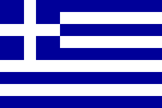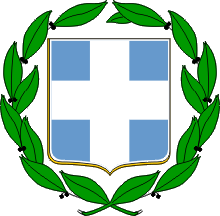Greek Flag |
Greek National Anthem |
Greek emblem
› The Greek Flag
The national flag of Greece consists of nine horizontal stripes of equal width, five blue and four white, alternately, the first and last stripes being blue. In the upper left corner is a blue square, which occupies the first five stripes and inside which is a white cross. The flag is hung on a white flagstaff at the top of which there is (on certain occasions) a white cross.

The Greek Flag
The design and colours (blue and white) of the national flag were laid down in January of 1822 at the first National Assembly at Epidauros. On 15 March of the same year the Executive Body (the Government), which had taken over the interim administration of Greece, specified by Decree 540 three types of flag: one land flag and two marine flags, one of which was for the navy and the other for the merchant marine.
The land flag was square in shape, and had a white cross on a blue background. The marine flags resembled today's national flag. The only difference in the flag of the merchant marine was the reversal of colors in the corner where the cross was (a blue cross on a white background). The flag of the merchant ships was ranked with that of the navy in 1828, when it was recognized that merchant ships had taken part in the war of independence as war-ships.
The national flag has been modified several times since then, mainly as a result of regime changes, without being radically altered. In 1833 the Bavarian coat of arms was added to the flags of the army and the navy and remained until the overthrow of King Otto in October of 1862. With the arrival of King George I in 1863 the crown was introduced into the flags of the above forces and remained there until the regime change in 1924.
From 1864 onwards the flag of the infantry regiments was made of silk with a gold fringe all round and had a picture of their patron saint, Saint George, in the center of the white cross.
The war flags today are, for the navy the national flag, and for the army and the air force a rectangular flag consisting of a white cross on a blue background, the cross dividing the flag into four equal parts. In the center of the cross, the flag of the army bears a picture of Saint George, while the flag of the air force bears a picture of the Archangel Michael.
› The National Emblem

The Greek National Emblem
The national emblem of Greece consists of a blue escutcheon with a white cross totally surrounded by two laurel branches.
The emblem is painted or woven, mainly on the hats, uniforms and buttons of the military, the security forces etc.
The Greek national emblem was provided for by the Constitution of Epidauros of 1 January 1822 and was established by decree on 15 March of the same year. It was blue and white and circular in shape.
Since it was first established the emblem has undergone many changes in shape and in design, mainly due to changes of regime.
The original Greek national emblem depicted the goddess Athena and the owl. At the time of Capodistrias, the first Prime Minister of modern Greece, the phoenix, the symbol of rebirth, was added. During the reign of King Otto, the royal crest, with two crowned lions holding the coat of arms with the royal crown, became the national emblem of the country. With the arrival of King George I, the Bavarian emblem was replaced by the Danish one. After Greece became a republic in 1924 the national emblem consisted of a simple white cross on a blue background. The Danish emblem returned with the restoration of the Monarchy until 1967.
› The National Anthem
The National Anthem of Greece consists of the first two verses of the poem "Hymn to Freedom" which was written in May 1823 in Zakynthos by the poet Dionysios Solomos. A year later it was published in Mesolonghi and the same year Foriel included it in a collection of Greek folk songs. In 1828, Nicholas Mantzaros, a Corfu musician and friend of Solomos, set the poem to music, based on a folk theme, not as a march but for a four-voice male choir. After that the "Hymn to Freedom" was regularly heard on national holidays.
(Greek)
Σε γνωρίζω από την κόψη
του σπαθιού την τρομερή,
σε γνωρίζω από την όψη
που με βία μετράει τη γη.
Απ’ τα κόκκαλα βγαλμένη
των Ελλήνων τα ιερά,
και σαν πρώτα ανδρειωμένη,
χαίρε, ω χαίρε, Ελευθεριά!
(Greek transliterated)
Se gnorízo apó tin kópsi
tou spathioú tin tromerí,
se gnorízo apó tin ópsi
pou me vía metrái ti gi.
Ap’ ta kókkala vgalméni
ton Ellínon ta ierá,
ke san próta andrioméni,
chére, o chére, Eleftheriá!
(A translation in English
by Rudyard Kipling, 1918)
We knew thee of old,
Oh, divinely restored,
By the lights of thine eyes,
And the light of thy Sword,
From the graves of our slain,
Shall thy valour prevail.
As we greet thee again-
Hail, Liberty! Hail!
The Greek National Anthem (video)
In 1844 the poem was set to music for a second time by Mantzaros, and submitted to King Otto in the hope that it would be accepted as the national anthem. In spite of N. Mantzaros being awarded the Silver Cross of the Order of the Redeemer and D. Solomos the Gold Cross of the same Order, the work was not ratified as the national anthem but became popular as a battle song.
In 1861 the Minister for the Military asked Mantzaros to compose a march based on the "Hymn to Freedom". The musician altered the rhythm of Solomos' hymn, giving it the rhythm of a march and in 1864, after the union of the Ionian Islands with Greece, the "Hymn to Freedom" was established as the national anthem. The national anthem, along with its music, was printed for the first time (27 copies) in London in 1873.
The poem "Hymn to Freedom" consists of 158 four-line verses of which the first 24 verses were established as the National Anthem, in 1865. Of these the first two are those which are usually played and which always accompany the raising and the lowering of the flag and are sung on official occasions. During the playing of the national anthem one stands to attention.